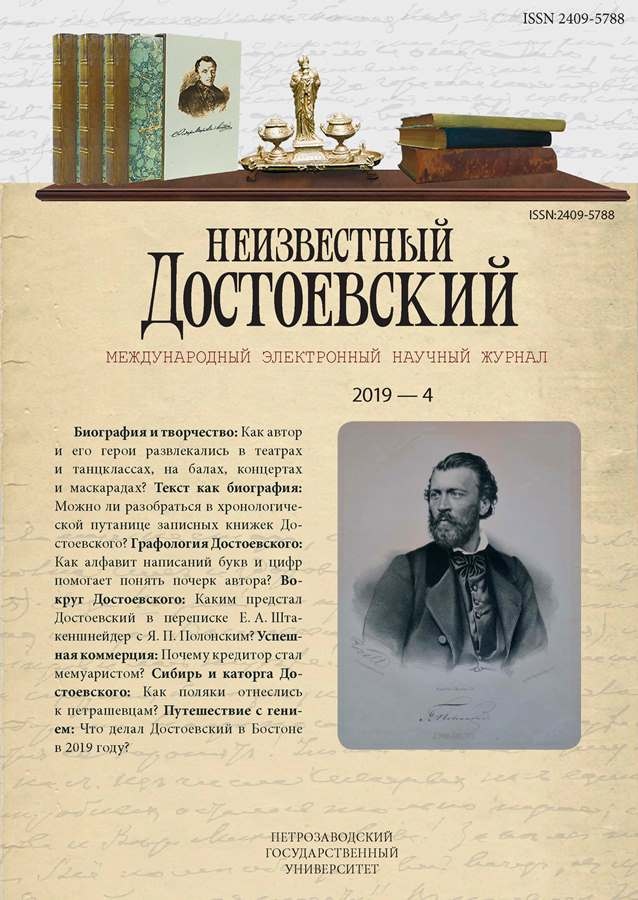Том 9, № 2 (2022)
Статьи
Принципы создания электронного каталога графики на материале рукописей Ф. М. Достоевского
Аннотация
В статье обосновываются принципы исследования графического содержимого рукописных текстов Достоевского и создания электронного каталога графических образцов, в который вошли бы наиболее репрезентативные примеры почерка писателя и их научное описание. Материалом исследования являются рабочие тетради Достоевского, которые включают записи различного характера: черновые наброски к художественным замыслам и к публицистике, черновики писем, заметки для памяти, адреса, расчеты бытового и редакционно-издательского содержания. Разнообразие исследуемого материала позволяет собрать более информативные и полные данные о специфике графических характеристик в текстах писателя. Анализ и систематизация особенностей почерка, типичных и нетипичных начертаний, продуктивны при расшифровке так называемых «трудных чтений» и имеют значение для понимания смыслового контекста записей Достоевского, в ряде случаев позволяя уточнить важную фактическую информацию. Практическая ценность исследования заключается в возможности использовать полученные данные при изучении трудночитаемого почерка, неразборчивых написаний, а также при анализе невербальных форм графики Достоевского и их роли в творческом процессе автора. Для решения этих задач разработан специальный инструментарий, позволяющий произвести исследовательский отбор графических изображений и дать их описание.
 5-36
5-36


Каллиграфические элементы в почерке Достоевского как текстологическая проблема
Аннотация
В статье рассматривается сложный случай установления статуса рукописи, написанной почерком с элементами каллиграфии, когда затруднительно определить, что перед нами: беловой автограф или писарская копия? Предметом текстологического анализа стала рукопись первой «сибирской оды» Достоевского «На европейские события в 1854 году», при публикации которой в нескольких авторитетных изданиях по-разному решался поставленный вопрос. В академическом Полном собрании сочинений Достоевского (в 1-м и 2-м изданиях) рукопись стихотворения, хранящаяся в ГА РФ (фонд III Отделения), квалифицирована, хотя и не без колебаний, как беловой автограф. В петрозаводском Полном собрании сочинений («Канонические тексты») статус рукописи определен как писарская копия. В статье показано, что расхождение в выводе авторитетных текстологов обусловлено уникальностью данной рукописи, написанной особой разновидностью почерка с элементами каллиграфии, в котором многие начертания букв ориентированы на образцы, закрепленные в учебных прописях 1830–1850-х гг. При установлении статуса рукописи использована методика двойного сопоставления почерка, которым она написана: с одной стороны, с каллиграфическими записями из рабочих тетрадей Достоевского 1860-х гг., с другой — с образцами из учебных прописей. Это позволило выявить ряд индивидуальных черт, присущих писателю именно в версии почерка с элементами каллиграфии, прежде всего в начертаниях прописных букв, и твердо установить, что перед нами беловой автограф. Одновременно анализ почерка позволил сделать заключение об особом психологическом состоянии Достоевского, в котором он находился в апреле 1854 г., через три месяца после выхода из острога, когда им писалась рукопись патриотического стихотворения «На европейские события в 1854 году», предназначенная для отправки официальным путем в столицу с надеждой на публикацию в «С.-Петербургских ведомостях».
 37-57
37-57


Достоевский как прототип незавершенной повести Некрасова «В тот же день часов в одиннадцать утра…»
Аннотация
В статье рассматриваются дискуссионные вопросы изучения незавершенной повести Н. А. Некрасова о Ф. М. Достоевском. Некрасов сыграл важную роль в становлении литературной репутации Достоевского. Роман «Бедные люди» стал литературной сенсацией 1845–1846 гг., а его автор был назван гением. В середине 1850-х гг. Некрасов предпринял ревизию этих событий. Прототипами его персонажей являются реальные лица. В повести представлены характеры трех лиц: Мерцалова (Белинского), Глажиевского (Достоевского), Чудова (Некрасова). Их образы типичны и однозначны. Мерцалов противоречив: он восторженно встретил молодого писателя, но жесток и требователен к «литературным сочувствователям», которых воспринимает как слуг. Положительным героем показан лишь Чудов. Он честен, не интриган, критичен ко всем участникам этой литературной истории, осуждает интриги и сплетни. Он — герой произведения и alter ego автора. Как прототип Достоевский изображен в тексте Некрасова в трех ракурсах. Выступая в амплуа мемуариста, Некрасов представляет Достоевского как писателя и как историческое лицо. В этих эпизодах преобладает документализм, автор использует факты биографии писателя, оказавшегося в эпицентре петербургской литературной жизни середины 1840-х гг. В амплуа критика Некрасов анализирует творческий опыт раннего Достоевского, узнавая в авторе Макара Девушкина и Голядкина. В амплуа журналиста и редактора Некрасов представляет Достоевского персонажем сплетен, слухов, сатирического послания Белинского Достоевскому, фельетонов И. Панаева. Это утрированный и карикатурный образ юного гения, не готового к этой роли, несостоятельного как личность, а потому осмеянного и отвергнутого окружением Белинского. Некрасов сделал историю Глажиевского назидательной. Автор разоблачает своих героев. В характерах героев есть противоречия, но нет сложности. Ему интересно событие, но не его участники. Сначала Некрасов увлекся темой, но позже потерял к ней интерес.
 58-85
58-85


Кризис библиографического отдела: писал ли Достоевский рецензии для «Гражданина»?
Аннотация
В 10-м, 11-м и 12-м номерах «Вестника Европы» за 1872 г. под псевдонимом А. И. Пальма «П. Альминский» была опубликована первая часть романа «Алексей Слободин. Семейная история». В еженедельнике «Гражданин» (1873 г., № 1) был размещен анонимный критический отзыв на это произведение Пальма. В записной тетради Ф. М. Достоевского 1872‒1873 гг. есть отметка «Мещерский — Алексей Слободин», и Е. Н. Коншина в 1935 г. связала эту запись писателя с отзывом на роман Пальма. Впервые о том, что возможным автором данного критического текста является Достоевский, заявил В. В. Виноградов. Исследователи пытались решить вопрос об авторстве однозначно: либо Достоевский, либо Мещерский. Однако редакторская работа Достоевского предполагала различные формы взаимодействия. Рецензия на роман «Алексей Слободин. Семейная история» строится на концепции о художественных типах, которая была разработана Достоевским. Он дал задание Мещерскому и составил план рецензии. В критическом отзыве присутствуют несколько фрагментов, которые позволяют признать Достоевского соавтором. Так, обращение к типу Савелия Туберозова предшествует размещенной в четвертом номере рецензии на роман Н. С. Лескова (Стебницкого) «Соборяне». Наблюдается сходство в описании этого образа. Достоевский в анализе лесковского произведения раскрывает концепцию типа более детально, нежели Мещерский. Полемика с А. Н. Пыпиным, обнаруживаемая в рецензии на роман Пальма, также принадлежит Достоевскому. Заметно непостоянство стиля, что указывает на работу над текстом одновременно двух авторов: Мещерского и Достоевского. В статье представлены дополнительные доводы в пользу того, что Достоевский являлся одним из авторов рецензии на роман Лескова «Соборяне». Математические методы, использованные в данном исследовании, подтверждают эту гипотезу.
 86-99
86-99


«Тем не менее дим идет»: выписки из статьи М. Куторги в рукописях Ф. М. Достоевского
Аннотация
«Дневник Писателя» являет собой пример уникальной журналистской манеры Достоевского, работавшего во многих публицистических жанрах, в том числе — в жанре политического обозрения. Современные внутрироссийские и международные события писатель анализировал, не только опираясь на большой объем столичной, провинциальной и иностранной прессы, но и обращаясь к примерам далекой и близкой истории. Ярким образцом такого рода обращений являются выписки из статьи русского антиковеда М. С. Куторги, встречающиеся в рабочих материалах к «Дневнику Писателя» за 1876 г. Достоевского интересуют приводимые Куторгой мысли Платона и Аристотеля о тирании, демократии, монархии, олигархии, а также — о реформах Солона. В настоящей статье дается фактологический и текстологический комментарий к выпискам, определяется их связь с содержанием записной тетради 1875–1876 гг. Факты античной истории, осмысленные древнегреческими философами и вслед за ними — русским ученым-историком, находят отклик в историософской концепции Достоевского, отстаивающего монархические и православные позиции.
 100-116
100-116


Терминологический тезаурус евангельского текста Ф. М. Достоевского
Аннотация
В статье рассмотрена актуальная проблема терминологического описания «евангельского текста» Достоевского, в основе которого лежит тезаурус как базовый лексикон научного языка. Соответственно цель и задачи статьи — экспликация терминологического тезауруса «евангельского текста», функционирующего в исследованиях о Достоевском и содержащего ключевые понятия общей (теоретической) поэтики, исторической поэтики, этнопоэтики, богословия и философии. В отношении этой терминологии реализован тезаурусный подход, в рамках которого соединяются «машинный анализ» и «человеческая интерпретация» исходных данных. Представленный терминологический словник достаточно репрезентативен для современного состояния изучения евангельского текста Достоевского. Визуальные результаты его цифровой обработки наглядно показывают тенденцию к совместному словоупотреблению поэтологических, богословских и философских категорий. Отсюда сделан вывод о том, что анализ терминологического тезауруса продуктивен для решения вопроса, насколько целостен метаязык исследований евангельского текста Достоевского, который в своем современном состоянии отличается большой интердискурсивностью.
 117-136
117-136


Ф. М. Достоевский в Иране: «тройной» перевод
Аннотация
Творческое наследие Ф. М. Достоевского всегда вызывало интерес у иранских исследователей и любителей русской словесности. Статья посвящена исследованию влияния Достоевского на становление и развитие персидской словесности. Это влияние нашло свое выражение в таком своеобразном явлении, как тройной перевод: перевод романа Достоевского на персидский язык, перевод литературного текста на кинематографический язык, перевод христианского содержания на язык исламской культуры. В статье содержится анализ экранизации картины «Белые ночи», вышедшей на экраны в 2002 г. Автор сценария к фильму — Саид Агиги, автор постановки — выдающийся иранский кинорежиссер Фарзад Мотамен. Художественный фильм является свободной адаптацией романа Достоевского «Белые ночи» к современным персидским пространственным, временным, культурным и религиозным особенностям. Его можно считать единственной успешной экранизацией иранским кинематографом произведений русской классики. Фильм стал результатом творческого диалога переводчика, сценариста и режиссера с автором, взаимодействия и взаимообогащения разных видов искусств, национальных культур и конфессий, литературных, философских и религиозных кодов коммуникации.
 137-148
137-148


«Я один из многих учителей русской литературы»: памяти Роберта Луиса Джексона (1923–2022)
 149-153
149-153












